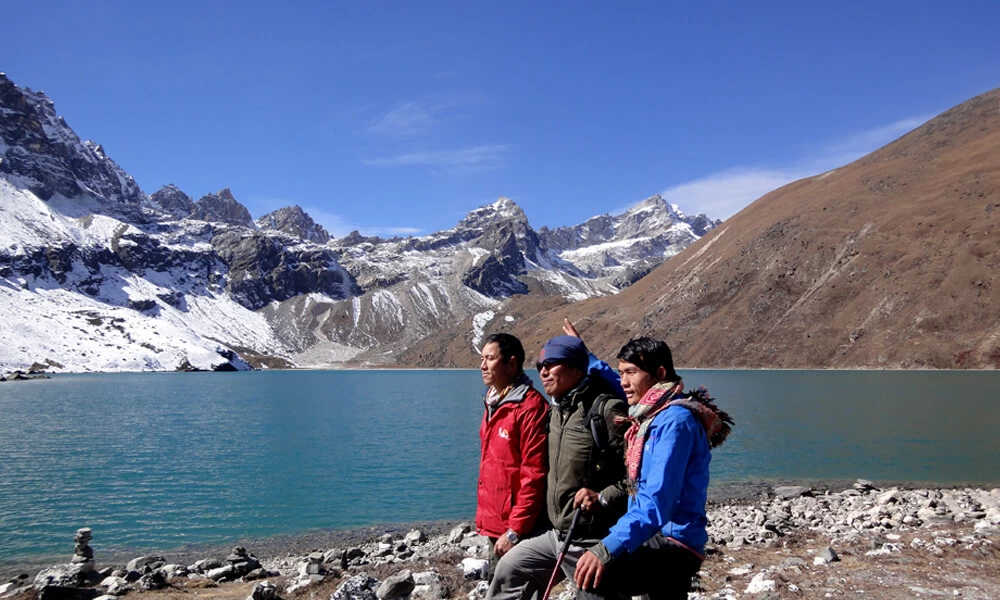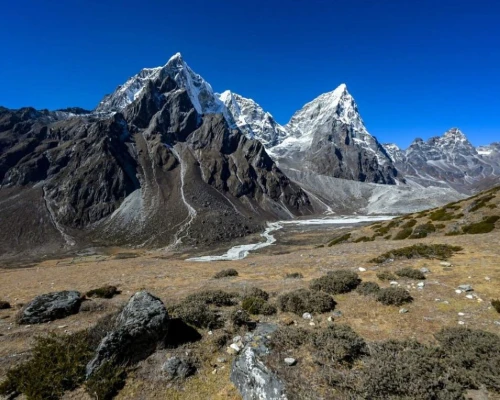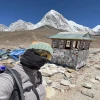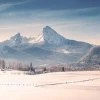Everest Base Camp 15-Days Trek Overview
Everest Base Camp Trekking is one of the most popular and adventurous journeys among trekkers. The trek begins at Phakding and follows the Dudh Kosi River, leading to Namche Bazaar, a bustling hub for trekkers, local Sherpas, and expeditions heading towards Mt. Everest. Along the way, we pass through lush forests of rhododendrons, magnolia, and towering firs, making the journey even more mesmerizing.
The best time for Everest Base Camp trekking is during autumn (September to November) and spring (March to May), when the weather is clear, and flowers bloom beautifully. After trekking through high mountain trails, we get an enchanting view of Mt. Everest. A two-hour walk leads us to the famous Tengboche Monastery (3,867 m), surrounded by dwarf firs and rhododendrons.
Continuing our journey, we descend to Imja Khola, passing through the villages of Pangboche and Pheriche, and finally reaching the Khumbu Glacier. Lobuche offers a vantage point for breathtaking views of Ama Dablam and other Himalayan peaks. The final ascent to Kala Patthar (5,554m) rewards us with spectacular panoramic views of the Himalayas, including the majestic southwest face of Mt. Everest. After reaching Everest Base Camp at the foot of the Khumbu Icefall, we make our way back to Lukla, completing this unforgettable adventure.
The Everest Base Camp trek can be customized based on your preferences and vacation schedule. However, the ideal time to embark on this journey is from March to May and from September to December.
Short itinerary
Day 1: Arrival in Kathmandu (1400m), upon landing at Tribhuban International Airport, transfer to your hotel and rest after your journey. Overnight at Kathmandu Suite home.
Day2: Kathmandu sightseeing & Trek preparation:- Explore Kathmandu's World heritage sites, including swayambhnath, ( monkey temple ), Pashupatinath Temple, Boudhhanath Stupa, and Kathmandu Durbar Square, in the evening attend trek briefing and prepare for adventure. Overnight at Kathmandu suite home.
Day3: Flight to Lukla & Trek to Phakding (2,610m):- Take a scenic 35-40minute flight from Kathmandu to Lukla (2840m) or Drive 5-6 hours to Manthali/Ramechhap (474m) Followed by a 20minute flight to Lukla. Begin 3-4 our trek to Phakding. Overnight at guesthouse.
Day 4: Trek to Namche Bazar (3,440m)
Trek 5-6 hours through lush forest and across a suspension bridge before reaching the bustling Sherpa town of Namche Bazaar. Overnight at a guesthouse.
Day 5: Acclimatization & hike to Hotel Everest view (3,880 m):-Spend the day adjusting to the altitude with a hike to Hotel Everest view, offering stunning mountain vistas. Return to Namche. Overnight at a guest house.
Day 6: Trek to Tengboche (3,860 m):- Hike 5-6 hours through scenic trails to Tengboche, home to a famous monastery with Panoramic Himalayan views. Overnight at a guesthouse.
Day 7: Trek to Dingboche (4,410 m):- Continue trekking for 5-6 hours, enjoying breathtaking views of Ama Dablam and surrounding peaks. Overnight at a guest house.
Day 8: Acclimatization and hike to Nangkartsang Peak (5,083 m):- To adapt to the altitude, hike up Nangkartsang Peak, offering spectacular views of Everest, Lhotse, and Makalu. Return to Dingboche. Overnight at a guesthouse.
Day 9: Trek to Lobuche (4,910 m): A 5-6 Hour trek through the rocky terrain of the Khumbu Glacier leads to Lobuche. Overnight stay at a Guesthouse.
Day 10: Everest Base Camp (5,364 m) & Return to Gorak Shep (5,190 m): Trek 8-9 hours to reach the legendary Everest Base Camp, then descend to Gorakshep. Overnight at a guesthouse.
Day 11: Hike to Kala Patthar (5,555m) and Descend to Pheriche (4,240m)
Start early to witness the sunrise over Mount Everest from Kalapathar. Later, descend to Pheriche in a 7-8 hour Journey. overnight at a guesthouse.
Day 12: Trek to Namche Bazaar (3,440 m) : Retrace the route back to Namche with a 7-8 hour trek. Overnight at a guesthouse.
Day 13: Trek To Lukla (2,840m): Conclude the trek with a final 7-8 hour walk back to Lukla.
Day 14: Flight back to Kathmandu.
Day 15 ; Final Departure.
Which is the Best Time for Everest Base Camp Trek.
The Everest Base Camp trek is an adventure of a lifetime, but choosing the right season is crucial for a safe and rewarding experience. The best time to trek largely depends on weather conditions, visibility, and overall trail accessibility. Spring (March to May) is one of the most preferred seasons due to its mild temperatures and clear skies. During this time, the trails are lined with blooming rhododendrons, making the journey visually stunning. It is also a peak climbing season, so trekkers may encounter mountaineering expeditions heading towards the summit of Everest. The weather remains stable, offering breathtaking panoramic views of the snow-capped peaks.
Another highly favorable time for the trek is autumn (September to November) when the monsoon rains have cleared the atmosphere, leaving behind crisp air and unobstructed mountain views. The temperatures are comfortable for trekking, and the trails remain dry, reducing the risks associated with slippery paths. This season also provides an opportunity to witness Nepal’s vibrant festivals like Dashain and Tihar, adding a cultural experience to the adventure. However, since both spring and autumn are peak trekking seasons, the trails and teahouses can get crowded, especially in areas like Namche Bazaar and Tengboche.
For those who seek solitude and a more challenging experience, winter (December to February) is an option, though temperatures can drop significantly, especially at night. Snow-covered landscapes make the trek visually stunning, but the extreme cold and the possibility of trail closures due to heavy snowfall make it a less popular choice. On the other hand, summer/monsoon (June to August) is the least recommended time for trekking due to heavy rains, landslides, and poor visibility. Flight delays and cancellations are common during this period, making the journey unpredictable.
Ultimately, the best time to trek Everest Base Camp depends on personal preference and preparedness. Spring and autumn remain the top choices for an enjoyable and safe trekking experience, while winter and monsoon treks require extra caution and planning.
How can this trek be the most unforgettable journey of your life?
Take an exciting flight to Lukla, one of the tiniest and most extreme airports in the world.
Explore the lively Sherpa town of Namche Bazaar.
Hike to Everest View Hotel and Khumjung village, home to one of the finest hotels, often referred to as a five-star of the Everest Region.
Find the variety of flora and fauna located in the high altitude of Sagarmatha National Park.
Explore the diverse wildlife and plants.
Admire the stunning Khumbu Icefall and Khumbu Glacier.
Visit the largest monastery of the Khumbu region of Tengboche, and enjoy the surrounding spectacles of the Himalayas.
Walk alongside four touring mountains: Mount Everest, Cho Oyu, Lhotse, and Makalu.
Experience the unique culture of the Sherpa people.
Stand at the foot of Mount Everest, the highest peak of the world.
Visit the Sherpa museum and learn about the mountaineering Sherpa lifestyle.
Immerse yourself in the breathtaking views of sparkling peaks of Mount Everest, Lhotse, Makalu, AmaDablam, Nuptse, Pumori, lingerie, Thamserku, Lhotseshar, Kangtega, Tauche, Choletse, and many more.
What happens if you have altitude sickness during the trek?
Trekking to Everest Base Camp is a challenging journey due to the high altitude and reduced oxygen levels. The highest point of the trek, Kala Pathar (5545m), offers breathtaking views but also increases the risk of altitude throughout the trek, which remains around 4000 meters, making acclimatization essential.
To minimize risks, we ensure proper acclimatization days throughout the journey. However, altitude sickness can still occur, especially for those who are not well-prepared physically or mentally. Symptoms may include headache, dizziness, nausea, loss of appetite, and breathlessness. If these symptoms appear, immediate action is required. The best way to recover is by resting, staying hydrated, and descending to a lower altitude if necessary.
We strongly recommend prior trekking experience above 3500 to help your body adapt better. Walking at a comfortable pace is also crucial, as rushing can increase the chances of altitude-related issues.
With proper preparation, guidance, and support, you can complete the Everest Base Camp Trek safely and enjoy the journey.2025/2026 will be an ideal time to explore the stunning Sherpa culture, majestic mountains, and unique Himalayan landscapes. Our expert team at Outshine Adventures is the best choice here to ensure you have a trip without any travel hassles.
Are you Mentally Prepared for the Everest Base Camp Trek?
The Everest base camp trek is a once-in-a-lifetime adventure, but it's important to remember that this trek isn't just about physical stamina; it's a true mental challenge. Trekking at high altitudes, sometimes for up to 5 to 6 hours a day in rugged terrain, demands not only strength but also mental resilience.
Throughout the journey, you will be ascending between 300 to 700 meters daily. The higher altitude will place more strain on your body, so it's important to ensure both your body and mind can adapt to the challenging conditions. If you're not accustomed to trekking at high altitudes, it may be helpful to complete a trek at lower altitudes before attempting Everest.
Accommodation during the trek will be at local teahouses that provide basic but clean and comfortable facilities. These rooms won't offer the luxury of city hotels, but they are cozy and offer a welcoming experience in the heart of the mountains.
The weather in the Himalayas can be unpredictable, especially at the higher altitudes. You may encounter cold temperatures, snow, and harsh conditions. Preparing with the right layers of clothing and weather-resistant gear is crucial, even if you're trekking during the warmer months.
We give you key aspects to consider in preparing mentally for this iconic Everest base camp trek.
Trekking in the Himalayas means dealing with unpredictable factors, such as weather delays or physical discomfort. Mental fortitude comes into play when facing challenges like altitude sickness, extended days of hiking, and other unforeseen hurdles. Patience and flexibility will be your best assets.
Focus on the reward—every day brings its challenges, but keeping the breathtaking views of Mount Everest and the opportunity to reach its base camp in sight will help you maintain your mental strength. The trek may test your limits, but the incredible reward is worth it.
A positive mindset can transform a challenging experience into a fulfilling one. The trek requires you to stay calm and focused, especially during tougher days. Being mentally prepared will allow you to embrace the journey and the changes that come with it.
While physical fitness plays a vital role, the mental preparation for the trek can often be the determining factor for success. If you are prepared to face the journey's challenges with a clear mind and determination, the Everest Base Camp Trek will be an unforgettable adventure.
The Complete Guide to Obtaining a Permit for The Everest Base Camp Trek.
Trekking to Everest Base Camp (EBC) is a dream for many adventure enthusiasts.
However, before setting off on this iconic journey, obtaining the necessary permits is crucial. These permits regulate entry into the Everest region, ensuring environmental conservation, sustainable tourism, and the safety of trekkers.
Why it's important?
The permits serve as an official authorization to enter the restricted areas. Without them, trekkers will be denied entry at various checkpoints along the route.
Sagarmatha conservation area, is home to diverse wildlife, glaciers, and fragile ecosystems. Permit fees contribute to pthe rotection and maintenance of Sagarmatha National Park, ensuring sustainable trekking for future generations.
The Khumbu Pasang Lhamu rural municipality Entrance Permit helps fund Local infrastructure, including trail maintenance, emergency services, and waste management.T his supports both trekkers and residents.
Permits help authorities keep track of trekkers, making it easier to assist in case of emergencies such as altitude sickness or extreme weather
condition.
Types of permit required for the Everest Base Camp Trek.
.Khumbu Pasang Lhamu rural municipality entrance permit.
This permit can be purchased at lukla or the national park entrance gate, cost NPR 3000 Per person.(approx. USD 22 ).
Sagarmatha National Park Entry permit.
This permit can get at the Nepal Tourism Board office in Kathmandu or at the national park Entrance gate in Manjo, Which cost 3000 NPR per person (approx. USD 22)









 based on 2 reviews
based on 2 reviews
